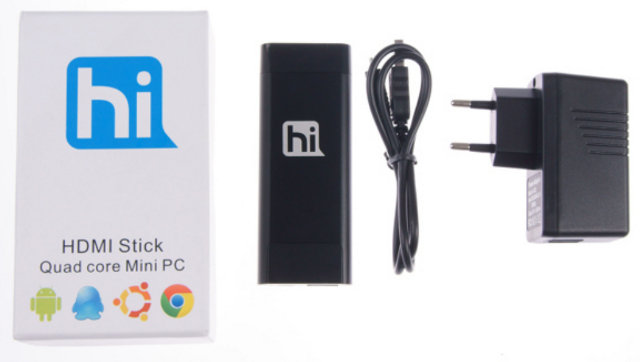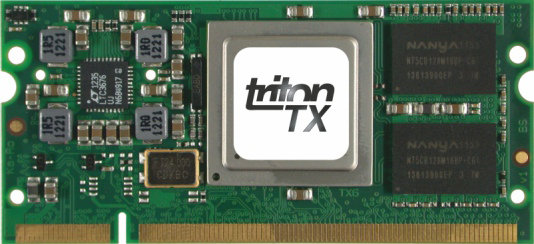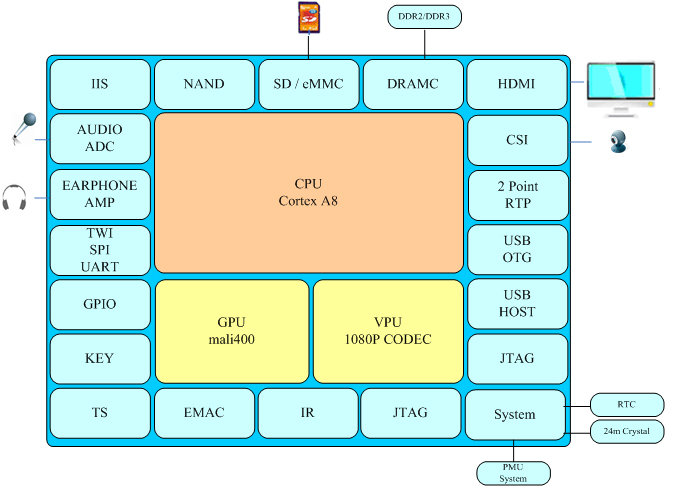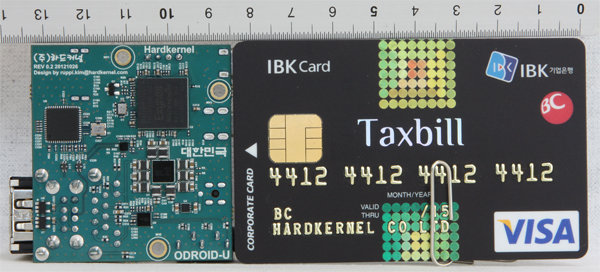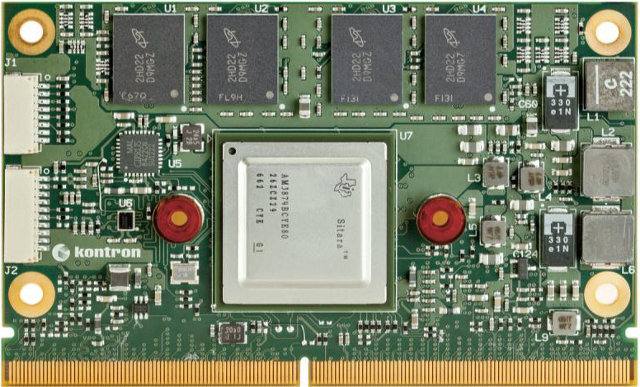After many delays allegedly due to Freescale i.MX6 CPU delivery issues, Hiapad HI-802 mini PC appears to be now available for purchase on Aliexpress for $99 including shipping. This HDMI dongle features Freescale i.MX6 Quad, 1GB RAM and 8GB Flash. The specs on Aliexpress are similar to the original announcement, except the internal NAND flash size is 8GB instead of 16GB: SoC – Freescale i.MX6 Quad Core Cortex A9 @ 1.2GHz with Vivante GC2000 System Memory – 1GB DDR3 RAM Storage – 8GB Nand Flash + microSD card socket Connectivity 802.11b/g/n Build-in Bluetooth 2.1 No 3G support. Video Output – HDMI (Up to 1080p60) Video Container Formats – 3GP,MPEG4,AVI,RMVB,MKV,FLV etc. support 1080P HD Resolution Audio Formats – MP3/WAV/AMR/AAC; USB – Micro USB 2.0 OTG + USB 2.0 Host Power Supply – 5V/1.5A Dimensions – 102 x 38 x 10 mm Weight – 45 g This Android 4.0 (ICS) mini PC […]
Direct Insight TRITON-TX6Q System-on-Module Powered by Freescale i.MX6Q
Direct Insight, a British company, has recently announced the TRITON-TX6Q, a SODIMM system-on-module based on Freescale’s iMX6Q quad core Cortex-A9 processor running at 1 GHz with 1 to 2GB RAM and 128 MB flash. This module targets embedded applications including medical devices, digital signage, and industrial multimedia products. Here are the TRITON-TX6Q specifications: SoC – Freescale i.MX6Q 4x ARM Cortex-A9 up to 1GHz + Vivante GC2000, GC355 and GC320 graphics co-processors System Memory – 1GB or 2GB 64-bit DDR3 @ 1066MHz Storage – 128MB NAND Flash, 2 SD card receptacles on baseboard Display Connection – LCD controller 24-bit parallel up to 1080p, dual LVDS (optional). Resistive & capactive touch screen support. Connectivity – Ethernet 10/100 BaseT with PHY on module. USB – USB Host + USB OTG Peripherals and Interfaces: Up to 5x UART (RS232) with pin sharing 2x I2C, 1x 1-wire and 2x SPI interfaces SSP (synchronous serial /digital audio): […]
AllWinner A10s Processor Overview
Between the AllWinner A10 and AllWinner A13 processors, there’s now an alternative. AllWinner A10s is based on AllWinner A13 architecture (sun5i), but adds HDMI and Ethernet MAC which makes it suitable for mini PCs and set-top boxes. The first time I heard about this processor was in August with IP878 mini PC, and in October, one reader (Alex) informed me AllWinner had posted more details about his new processor. Here are the key features of this (relatively) new SoC: CPU/GPU – ARM Cortex-A8 Core with 32KB D-Cache/ 32KB I-Cache / 256KB L2 Cache, and Mali-400 VPU HD Video Decoding 1080p@30fps of VP8/6, H.264/H.263, WMV9/VC-1, WMV7/8, MPEG-4/2/1, Xvid codecs HD Video Encoding 1080p@30fps with H.264 codec Video Out – HDMI 1.4 (1080p), Memory Up to 1GB DDR2/DDR3 up to 533MHz (16/32 bits Data Bus) MLC/TLC/SLC/EF-NAND ECC 64-bit Peripherals: USB2.0 OTG, USB2.0 HOST (OHCI/EHCI) SD Card V.3.0, eMMC V.4.2 SPI, TWI and […]
2D/3D Graphics Linux Demo (X11, EGL, GLES2, Qt4) on AllWinner A10 Tablet
Xlab (Maxim Kouprianov) has tested 2D & 3D capabilities of AllWinner A10 SoC (with Mali-400 GPU) on a Ployer MOMO11 Bird Edition tablet running OpenEmbedded with kernel 3.0.52+ testing X11, EGL, OpenGL ES2 and Qt4 on the platform, and the results are pretty smooth as you can see in the video below, although there appears to be some flickering in LunaSysMgr demo. The tools used in the demos are xfwm4 (Xfce Windows Manager), es2gears_x11, cube (Qt), LunaSysMgr (Qt/WebOS) and glmark2-es2. Qt4 acceleration is done via XlibGL platform which in turns uses X11-EGL. He used the Mali drivers version r3p0 (mali400-gles20-gles11-linux-x11-ump) and xf86-video-mali on sunxi-linux github repository mainly maintained by rz2k. You can get more details on how to build Mali-400 support for AllWinner A10 on http://linux-sunxi.org/Mali400, and GPU benchmark results for A10 show the drivers seem to work as expected. Jean-Luc Aufranc (CNXSoft)Jean-Luc started CNX Software in 2010 as a part-time […]
$69 ODROID-U & $89 ODROID-U2 Exynos 4412 Development Boards
Hardkernel has just announced 2 tiny quad core development boards based on Exynos 4412 @ 1.4 GHz (as used in Samsung Galaxy S3) and Exynos 4412 Prime @ 1.7 GHz (as used in Samsung Galaxy Note 2) called respectively ODROID-U and ODROID-U2. The other difference is the U version comes with 1 GB RAM, and the U2 version with 2 GB RAM. Here are the specification the ODROID-U and ODROID-U2 boards: Processor – Samsung Exynos4412 @ 1.4 GHz (ODROID-U) or Exynos 4412 Prime @ 1.7 Ghz (ODROID-U2), which can be overclocked respectively to 1.8 GHz and 2 GHz. GPU – Mali-400 clocked at 400MHz (ODROID-U) or 440MHz (ODROID-U2), which can be overclocked respectively to 533 and 633 MHz. System Memory – 1GB LPDDR2 DRAM @ 800MHz (ODROID-U) or 2GB @ 880MHz (ODROID-U2) Storage – microSD socket, eMMC connector USB – 2x USB 2.0 Host ports, 1x USB 2.0 device for ADB/mass […]
Kontron Unveils ULP-COM-sA3874i Module Powered by TI Sitara AM3874
Kontron introduced ULP-COM-sA3874i, another family of computer-on-module based on ULP-COM standards, based on Texas Instruments Sitara AM3874 Cortex A8 processors that aims to drive down system costs for ultra-low power SFF (small form factor) solutions in military, industrial automation/HMI, digital signage and medical markets. Here are the technical specifications of this module family: CPU – Texas Instruments Sitara AM3874 Cortex A8 @ 800 MHz Main Memory – On-board 1 or 2 GB DDR3 depending on model. Flash – Onboard Up to 32GB NAND FLASH build option Graphics – Single Channel 18bit,24bit (18bit compatible) LVDS, and HDMI with dual independent displays support. Ethernet – 10/100/1000 MBit Ethernet USB – 2x USB 2.0, USB OTG SATA – 1x SATA Interface Interfaces – GPIO, I²C, 4x I²S, 2x CAN, 2x SPI, 4x UART Camera input – 10bit parallel interface PCI Express / PCI support – 1x PCI Express x1 Lanes Power Supply – […]
Linaro 12.11 Release with Linux Kernel 3.7 and Android 4.2
Linaro release 12.11 has just been announced, and includes Linux Kernel 3.7-rc2 and Android 4.2. The tracking version (stable release) uses Kernel 3.4.19. This release upgrade Android to version 4.2, adds support for Origen 4 Quad board, and you can now use perf profiling utility in Linaro Android. Initial GRUB support for ARM is now available, the Ubuntu Precise server image is back online and lots of updates have been done on the kernel, mainly for Android, device tree and big.LITTLE. Here are the highlights of the release: Android Platform Enablement Android upgraded from 4.1.2 to 4.2 to all the platforms Android builds are available for Origen 4412 board setup Improvements to click-through license infrastructure MP3 playback enabled for ARM Versatile Express and Samsung Origen (4210 and 4412) Fixed riff USB issue on newer laptops Testing/LAVA Re-enabled Android CTS testing Integrated the new Methanol browser test Upstreaming Perf patch was […]
SoC Power Measurement with ARM Energy Probes and Linux EAP Tools
Andy Green, TI Landing Team lead at Linaro, gave an interesting presentation entitled “How to measure SoC power” at Linaro Connect Europe 2012. This talk was specifically aimed at software engineers, so that they know how to properly measure power consumption, and take actions to optimize the software to decrease it. In the first part of the presentation, he gives an overview of electronics basics with definition of voltage, load, current and power, units used for power measurements (Clue: you need to use Watts), and how voltage, current and power can be measured with voltmeters and ammeters. When you want to measure power in a rail, you would usually insert a shun resistor, use a multimeter and derive the power from the resistance and the measured voltage (P=V2/R). He also gives details about regulator efficiency, choosing measurement sampling… There are 4 common measurements strategies: DC IN – Easiest way, gives the complete […]

